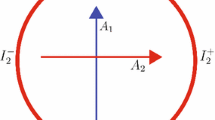Abstract
The two major ways of obtaining fundamental domains for discrete subgroups of SL(2,ℝ) are the Dirichlet Polygon construction (see Lehner in Discontinuous Groups and Automorphic Functions, American Mathematical Society, Providence, 1964) and Ford’s construction (see Ford in Automorphic Functions, McGraw–Hill, New York, 1929). Each of these two methods yield a hyperbolically convex fundamental domain for any discrete subgroup of SL(2,ℝ).
However, the Dirichlet polygon construction and Ford’s construction are not well adapted for the actual construction of a hyperbolically convex fundamental domain due to their nature of construction and their reliance on knowing almost all elements of the group under discussion.
A third-and most important and practical-method of obtaining a fundamental domain is through the use of a right coset decomposition as described below. Let Γ2 be a subgroup of Γ1 and
If \(\mathbb{F}\) is a fundamental domain of the bigger group Γ1, then the set
is a fundamental domain of Γ2. One can ask at this juncture, is it possible to choose the right cosets suitably so that the set ℛΓ is hyperbolically convex? We will answer this question affirmatively for
Similar content being viewed by others
References
Ford, L.: Automorphic Functions. McGraw–Hill, New York (1929)
Beardon, A.F.: The Geometry of Discrete Groups. Springer, Berlin (1983)
Knopp, M.I.: Modular Functions in Analytic Number Theory. AMS Chelsea Publishing, New York (1993)
Kulkarni, R.S.: An arithmetic geometric method in the study of the subgroups of the modular group. Am. J. Math. 113, 1053–1133 (1991)
Lehner, J.: Discontinuous Groups and Automorphic Functions. American Mathematical Society, Providence (1964)
Newman, M.: Free subgroups and normal subgroups of the modular group. IJM 8, 262–265 (1964)
Newman, M.: A complete description of the normal subgroups of genus one of the modular group. Am. J. Math. 86, 17–24 (1964)
Newman, M.: Normal subgroups of the modular group which are not congruence subgroups. PAMS 16, 831–832 (1965)
Rankin, R.A.: The Modular Group and its Subgroups. Ramanujan Institute, Madras (1969)
Schoeneberg, B.: Elliptic Modular Functions. Die Grundlehren der Mathematische Wissenschaften in Einzeldarstellungen, Band 203. Springer, Berlin (1974)
Yayenie, O.: Hyperbolic convexity of a standard fundamental domain of a subgroup of a Hecke discrete groups. Temple University. Ph.D. thesis (2003, unpublished)
Author information
Authors and Affiliations
Corresponding author
Rights and permissions
About this article
Cite this article
Yayenie, O. H-convex standard fundamental domain of a subgroup of a modular group. Ramanujan J 16, 305–320 (2008). https://doi.org/10.1007/s11139-007-9094-9
Received:
Accepted:
Published:
Issue Date:
DOI: https://doi.org/10.1007/s11139-007-9094-9
Keywords
- Fundamental domain
- Hecke discrete groups
- Hyperbolic geometry
- h-convex set
- Modular group
- Right coset decomposition



